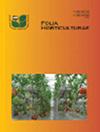纳米硒与亚硒酸盐对黄豆芽硒含量及营养品质影响的比较研究
IF 2.2
4区 农林科学
Q2 HORTICULTURE
引用次数: 2
摘要
摘要大豆芽是一种富含蛋白质、维生素C和异黄酮等营养成分的常见蔬菜。大豆还能积累硒(Se)。为研究硒生物强化对豆芽养分的影响,在水培试验中,采用10 μM、20 μM、40 μM、80 μM和100 μM浓度的硒纳米颗粒(SeNPs)和亚硒酸盐处理豆芽。结果表明,SeNPs和亚硒酸盐显著提高了豆芽中总硒浓度。在豆芽中检测到硒半胱氨酸、硒代蛋氨酸、甲基硒半胱氨酸、亚硒酸盐和硒酸盐5种硒形态,其中硒代蛋氨酸为优势硒形态。SeNPs和亚硒酸盐提高了大豆芽中叶绿素、类胡萝卜素、可溶性糖、可溶性蛋白、维生素C和异黄酮的含量。与亚硒酸盐处理相比,SeNPs处理导致丙二醛含量降低。SeNPs和亚硒酸盐均能提高谷胱甘肽含量。适量的硒刺激了过氧化氢酶的活性,大量的硒则降低了过氧化氢酶的活性。SeNPs和亚硒酸盐刺激过氧化物酶和抗坏血酸过氧化物酶活性。SeNPs对超氧化物歧化酶活性无显著影响。本研究表明,SeNPs是生产富硒豆芽的良好外源硒源。本文章由计算机程序翻译,如有差异,请以英文原文为准。
Comparative study of the effects of selenium nanoparticles and selenite on selenium content and nutrient quality in soybean sprouts
Abstract Soybean (Glycine max L.) sprouts are a common vegetable with rich nutrients, such as protein, vitamin C and isoflavones. Soybean is also capable of accumulating selenium (Se). To study the effects of Se biofortification on the nutrient of this crop, soybean sprouts were treated with different concentrations of selenium nanoparticles (SeNPs) or selenite (i.e., 10 μM, 20 μM, 40 μM, 80 μM and 100 μM) in a hydroponic experiment. Results showed that SeNPs and selenite remarkably increased the total Se concentration in soybean sprouts. Five Se speciations, namely, selenocystine, selenomethionine, methyl selenocysteine, selenite and selenate were detected in soybean sprouts, but selenomethionine was found to be the dominant Se speciation. SeNPs and selenite increased the contents of chlorophyll, carotenoid, soluble sugar, soluble protein, vitamin C and isoflavones in soybean sprouts. SeNPs treatments led to less malondialdehyde content compared with selenite. SeNPs and selenite both enhanced the glutathione content. The modest dosage of exogenous Se stimulated the catalase activity, whereas the large amount reduced it. The peroxidase and ascorbate peroxidase activities were stimulated by SeNPs and selenite. SeNPs posed no significant influence on the superoxide dismutase activity. This study suggests that SeNPs are a good exogenous Se source for the production of Se-rich soybean sprouts.
求助全文
通过发布文献求助,成功后即可免费获取论文全文。
去求助
来源期刊

Folia Horticulturae
Agricultural and Biological Sciences-Horticulture
CiteScore
3.40
自引率
0.00%
发文量
13
审稿时长
16 weeks
期刊介绍:
Folia Horticulturae is an international, scientific journal published in English. It covers a broad research spectrum of aspects related to horticultural science that are of interest to a wide scientific community and have an impact on progress in both basic and applied research carried out with the use of horticultural crops and their products. The journal’s aim is to disseminate recent findings and serve as a forum for presenting views as well as for discussing important problems and prospects of modern horticulture, particularly in relation to sustainable production of high yield and quality of horticultural products, including their impact on human health.
 求助内容:
求助内容: 应助结果提醒方式:
应助结果提醒方式:


